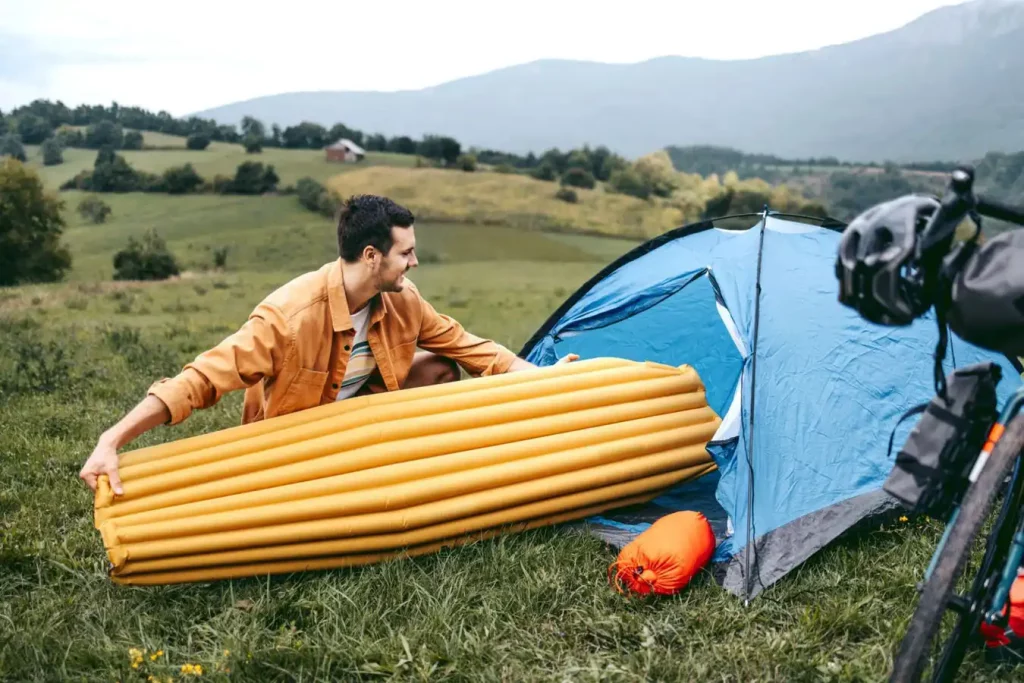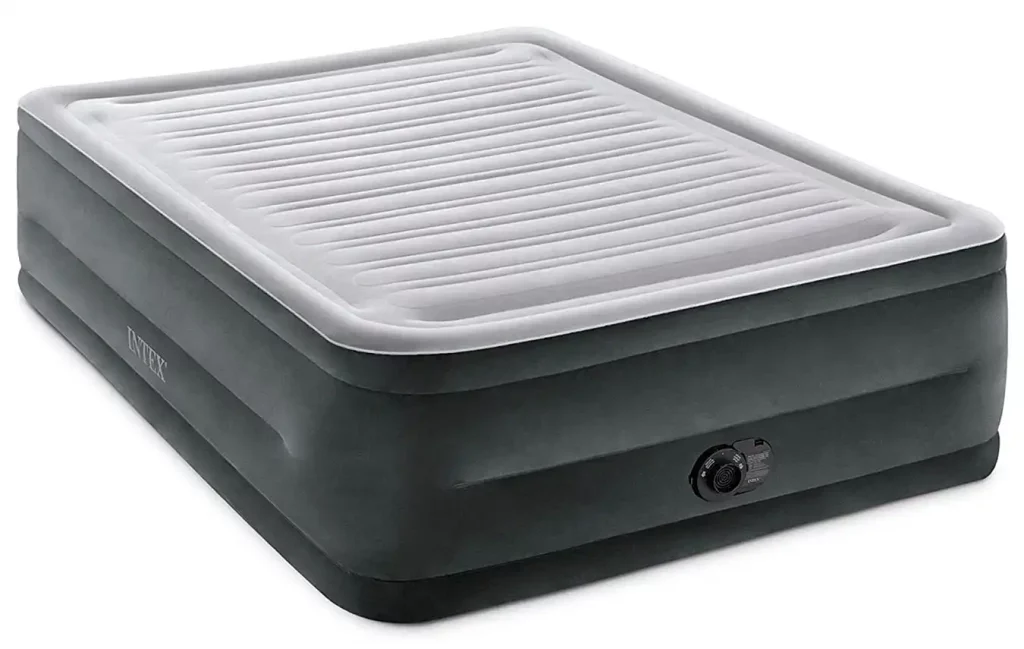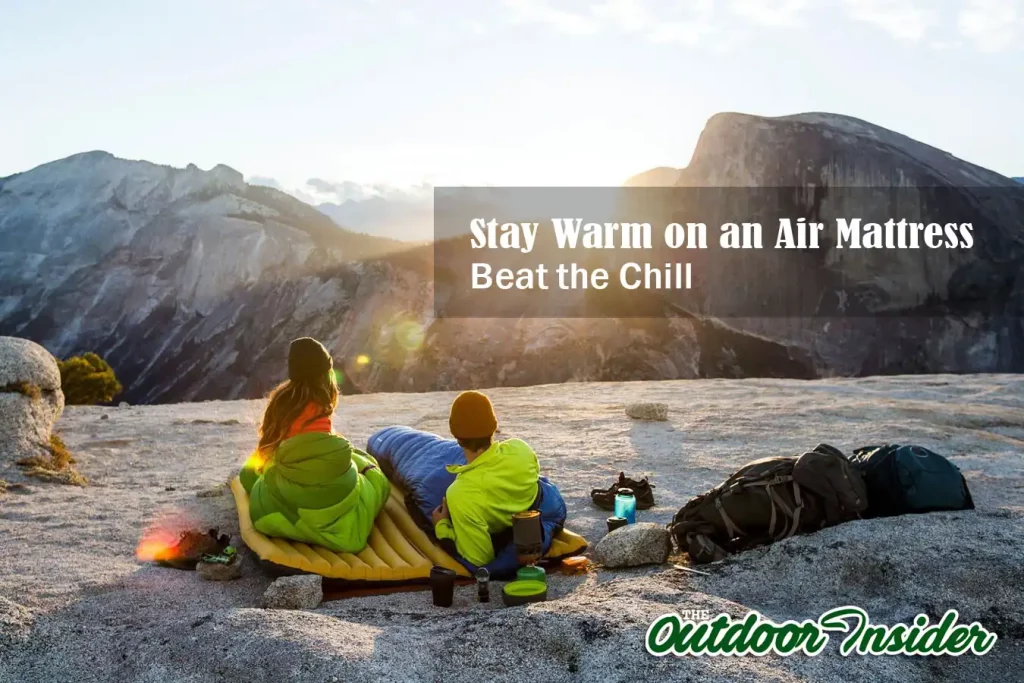“How to stay warm on an air mattress?” It’s a burning question, especially when camping on chilly nights.
Air mattresses offer convenience, but they can leave us shivering if we’re not prepared.
Is it about the right blanket? Or maybe a crafty technique?
In this guide, we’ll unveil the secrets to staying toasty while floating above the ground.
Brace yourself, because cold nights on an air bed are about to become a thing of the past.
Ready to beat the chill? Let’s dive in!
Understanding Air Mattress
Camping is a cherished outdoor activity, a time to connect with nature and break free from our busy city lives. But let’s face it: as magical as those starry nights can be, they can also get pretty chilly. And if you’re sleeping on an air mattress, finding warmth can be as elusive as spotting a falling star.

Understanding the Importance of Warmth When Camping
Think back to your last camping trip. You’re cocooned in your sleeping bag, the campfire embers are glowing, and you’re snug as a bug. That’s until you feel the first nudge of cold seeping through the air mattress, and suddenly, the allure of the great outdoors seems less enchanting.
Maintaining warmth isn’t just about comfort—it’s about safety. The outdoors can be unpredictable, and temperatures can plummet rapidly. Hypothermia is a real risk if we don’t take appropriate measures. After all, a well-rested camper is a happy camper, and staying warm is key to a good night’s sleep.
The Unique Challenges of Staying Warm on an Air Mattress
While air mattresses are incredibly convenient and comfy, they pose a particular challenge when it comes to heat retention. Why? It’s all to do with how heat transfers, and this brings us to our next point.
The Science of Staying Warm: Heat Transfer and Insulation
Let’s take a brief detour into the realm of physics. Don’t worry—we’re not going back to high school, but understanding some basic principles can go a long way in staying toasty warm on an air mattress.
Understanding Heat Transfer: Conduction, Convection, and Radiation
Heat transfer occurs through three primary modes: conduction, convection, and radiation. When you’re lying on an air mattress, conduction is the primary culprit stealing your warmth. It’s the process that occurs when heat travels from a warmer object (you) to a cooler object (the air mattress).
And here’s where the air mattress poses a problem. Air, which fills the mattress, is a poor conductor of heat but a good insulator. That sounds great until you remember that the ground underneath can be extremely cold. The air inside the mattress rapidly cools down, pulling more warmth from your body, and voila, you’re shivering instead of dreaming.
Importance of Insulation in Retaining Heat
Insulation acts as a barrier, reducing the heat exchanged via conduction and convection, which is why it’s a hot topic (pun intended) for campers. Effective insulation slows the heat loss from your body to the environment, and vice versa.
So, what’s the key to staying warm on an air mattress? Spoiler alert: it’s all about insulation. By understanding how heat transfer works, you can use insulation to your advantage, ensuring the cold ground doesn’t turn your cozy camping experience into a frigid fiasco.
Understanding the science behind heat transfer and insulation is the first step to conquering the cold while camping with an air mattress. But how can we apply this knowledge practically? Read next!
Choosing the Right Air Mattress for Warmth
Picking the right air mattress can make a significant difference in your camping experience. You might be tempted to choose based solely on size, convenience, or cost, but when it comes to braving the elements, the warmth factor should top your list.
The Role of Material and Design in Heat Retention
While all air mattresses rely on trapped air for cushioning, the material and design greatly impact their ability to retain heat. Check this on Amazon.

Air mattresses made from thicker material and incorporating multiple air chambers tend to offer better insulation. These layers and chambers reduce the rate at which heat is lost through conduction, keeping you warmer for longer. Some premium air mattresses also feature built-in insulation layers, such as reflective thermal layers or foam padding, to enhance heat retention.
As for design, a raised or double-height air mattress can provide additional insulation by elevating you further off the cold ground. However, they might be bulkier and heavier to carry around, so it’s a trade-off you’ll have to consider.
Top Air Mattress Brands for Warmth: An Expert Review
When it comes to brands, some consistently stand out for their dedication to ensuring a warm, restful sleep, even in colder climates:
- Therm-a-Rest: Known for its self-inflating mattresses (Amazon), Therm-a-Rest integrates advanced foam technology, offering excellent insulation and comfort.
- Exped: Exped’s range of air mattresses from Amazon often includes integrated pumps and microfiber filling, a fantastic insulator that also adds a touch of luxury.
- REI Co-op: Offering great value for money, REI Co-op’s air mattresses balance comfort, warmth, and affordability. Their mattresses often come with an R-value rating, which indicates the insulation efficiency, making your choice easier.
Remember, while these brands offer great options, personal preference and specific camping conditions should guide your final decision.
Enhancing the Warmth of Your Air Mattress
Even with the best air mattress, you might want extra warmth, especially in chillier conditions. Thankfully, there are plenty of ways to enhance your air mattress’s warmth, from mattress toppers to high-quality sleeping bags.
Using Mattress Toppers and Pads for Additional Insulation
Think of mattress toppers and pads as the secret weapon in your battle against the cold. These add an extra layer of insulation, preventing the cold ground from zapping heat away. Foam pads, in particular, offer excellent insulation and can be used under or on top of the air mattress.
Reflective thermal blankets can also be used effectively to combat heat loss. By reflecting your body heat back towards you, they reduce heat loss due to radiation.
The Value of High-Quality Sleeping Bags
Last but not least, don’t underestimate the value of a good sleeping bag. A well-insulated, mummy-style sleeping bag designed for the temperatures you’ll be encountering is an essential piece of gear for any camper. For added heat, consider sleeping bag liners that add a boost to your sleeping bag’s temperature rating.
As with any camping gear, a balance between comfort, warmth, portability, and cost is essential when choosing the right sleeping bag.
Staying warm on an air mattress is a combination of the right gear and understanding how heat transfer works. With these insights and strategies, your next camping trip can be a warm, comfortable adventure, no matter where it takes you.
Dressing for Warmth While Sleeping on an Air Mattress
Apart from choosing the right air mattress and enhancing its warmth, what you wear to bed plays a crucial role in keeping you warm. The trick lies in understanding layering and selecting the right materials for your sleepwear.
The Importance of Layering
Layering is not just for daytime hiking; it’s equally important when you turn in for the night. The goal here is to trap warm air close to your body, creating a natural insulation barrier. Start with a moisture-wicking base layer to keep sweat away, then add an insulating middle layer (like a fleece or down jacket), and finally, if it’s particularly cold, a shell layer to protect against wind or moisture.
Don’t forget about your head and feet! A lot of heat can be lost from these areas, so wearing a beanie and thermal socks can make a big difference in your comfort level.
Choosing the Right Materials for Sleepwear
While layering is key, the materials you choose for your sleepwear also matter. Natural materials like wool and silk are excellent insulators and good at managing moisture. Synthetic materials designed specifically for cold weather, such as polypropylene and polyester, are also good choices as they combine insulation with effective moisture-wicking capabilities.
Avoid cotton if you can, as it retains moisture and can make you feel colder when damp.
Tips and Tricks to Stay Warm on an Air Mattress
Armed with the knowledge of heat transfer, the right air mattress, and appropriate sleepwear, there are still a few more tricks to stay even warmer on an air mattress.
Pre-Warming the Mattress and Sleeping Bag
The idea of crawling into a cold sleeping bag on a chilly mattress isn’t appealing. A quick trick to avoid this is to pre-warm your sleeping bag and mattress. You can do this with a hot water bottle or even by tossing in a heat pack a few minutes before you plan to sleep. Just remember to remove it before you get in!
Using Hot Water Bottles or Heat Packs
Speaking of hot water bottles and heat packs, these can be your best friends on a cold camping night. Kept close to your body in your sleeping bag, they can provide a surprising amount of warmth. Just make sure they’re properly sealed to avoid any accidental leaks during the night.
Benefitting from Natural Heat: Selecting Your Camping Spot Wisely
Finally, remember that location matters. Setting up your tent in a spot that gets a good amount of afternoon sun can help warm up your sleeping area naturally. Additionally, look for natural windbreaks like rocks, trees, or hills to protect your campsite from chilling winds.
By applying these tips and tricks, you’ll be well-prepared to stay toasty warm on your air mattress during your next camping adventure.
Common Mistakes to Avoid When Trying to Stay Warm on an Air Mattress
While the tips provided so far will certainly help you stay warm on your air mattress, it’s also essential to be aware of common mistakes people make in the quest for warmth. Notably, these involve the risks of overheating and the often overlooked importance of ventilation.
Overheating: The Dangers and How to Avoid It
While it’s important to stay warm, there’s also a risk of overheating, especially if you’re using heating devices or wearing too many layers. Overheating can lead to a variety of health issues, including dehydration, heat stroke, and in severe cases, unconsciousness.
To avoid this, always be attentive to your body’s signals. If you start feeling too hot, don’t hesitate to remove some layers or turn off the heating devices. Remember, it’s easier to add layers if you get cold again than to cool down after overheating.
Ignoring the Importance of Ventilation
Camping in cold weather can make the idea of zipping up the tent and closing all the vents seem appealing, but this is a mistake. Proper ventilation in your tent is crucial to reduce condensation buildup, which can make your gear (including your air mattress and sleeping bag) damp and cold. Make sure you keep at least one vent open, regardless of how cold it is outside.
FAQs About How to Stay Warm On an Air Mattress
Why am I so cold sleeping on an air mattress?
Is it safe to use a heating blanket on an air mattress?
How do you sleep comfortably on an air mattress?
How can I make my air mattress warmer for camping?
Can you sleep on an air mattress as a bed?
Is there a downside to sleeping on an air mattress?
Final Thoughts
Keeping warm on an air mattress is a multifaceted endeavor, one that involves understanding heat transfer, choosing the right mattress and gear, and employing some clever tactics to enhance your warmth.
Staying warm on an air mattress involves choosing a mattress designed with warmth in mind, utilizing mattress toppers and sleeping bags, dressing wisely, and taking advantage of tricks like pre-warming your bedding or using heat packs. Always remember the importance of ventilation to avoid condensation, and be aware of your body’s temperature to prevent overheating.
At the end of the day, your comfort and safety while camping rely heavily on your preparation. A little extra planning and careful packing can be the difference between a miserably cold night and a cozy sleep under the stars, even on the chilliest of nights. So, before you set out on your next adventure, remember these tips, plan wisely, and stay warm! Stay warm and stay safe!


